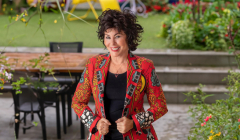
‘Being frazzled in the workplace has been dangerously normalised’
Comedian and actress Ruby Wax, Founder of mental health charity Frazzled, on taking stress seriously.

However much fake tan is involved, planner Leonie Hondeborg points out some very real benefits brands could reap if they learn from the biggest show of the summer.

Yes, that’s right. There are lessons to be learnt from watching a bunch of good-looking people sitting around in bikinis all day and discussing who’s cracking on with who.
You’ll either love it or hate it, but there is no denying that this show has become a cultural phenomenon. Getting so many young people tuning into the show at the same time every day and trending on social has proven that live TV is far from dead, or a dead ting. The live final was watched by over 4 million people, with 51% of this audience falling in the coveted 16-34 age range.
But I’ll spare you the goss and instead offer you the content marketing lessons Love Island has taught us this summer.
It’s not a secret that people are glued to two screens at a time and it’s no different for when they’re watching Love Island. Any time something juicy happens or a new word is born (‘refreshifise’ anyone?) fans immediately turn it into a meme, video or mention. Instead of competing with the other screen, ITV made them both complementary, creating an even better and more immersive viewing experience for fans.
During every episode, they had a team retweeting and replying instantly to fuel even more conversation. And pretty much around the clock they released new teasers, memes and cliff-hangers online, as well as sending timely push notifications from their own app. There was always a trove of new content to scroll through and build hype for the next episode.
Whilst you could say it’s just good practice to be reactive on social, Love Island took it to another level. Responding in real-time across multiple platforms, you’re not only becoming part of the conversation, you’re creating shared moments and a sense of community experience.
Before the first ad break everyone already knew that “it is what it is” was going to be the catchphrase of the 2019 series. Language is a huge part of what gives Love Island such a strong brand identity. It’s not only meme-gold, it’s also instantly recognisable and more relatable.
From ‘100% my type on paper’ to ‘Factor 50’, the islanders represent the regional and cultural language spoken by young Britons every day, but is rarely reflected back to them in such a mainstream channel. For once, the voices that commonly feel ignored are given centre-stage.
But the dialect has also been one of the biggest criticisms from haters of the show. From not using words longer than two syllables to breaking the record for number of ‘likes’ used in one sentence, it’s frequently been held up as proof of the dissent of the English language. Instead, I’d argue it’s more of an evolution – a shorthand that means just one Love Island phrase speaks a thousand words.
The show’s daily airing allows for the use of certain expressions to be incredibly consistent, so even the more nuanced terminology has entered the wider lexicon. Plus there’s an element of ‘if you know you know’ and using or just understanding particular phrases is a simple way to feel like an insider.
Naturally, lots of brands have jumped on the band wagon and joined in the conversation. For example, our TV Licensing campaign successfully used Love Island references to appeal to a younger audience.
Obviously, it needs to fit in with the brand and there’s nothing worse than a shoehorn. But the show’s huge influence has proved that, if used in the right way, colloquial phrases and memes can make brands seem more relatable and relevant, as well as building a more intimate interaction with their customers.
Lastly, they’ve mastered the art of anticipation, always leaving viewers with cliff-hangers and teasers. Even though this is standard practise in reality television, they managed to take this conversation online. Using a clever multi-channel strategy, they kept people engaged and always wanting more.
Every channel had a different role to play. For example, they repurposed content for bite-sized, digestible videos on Facebook and encouraged fans to tag their friends. Elsewhere on the app they used quizzes to engage fans and prompt interaction, whereas the infamous ‘First Look’ series on YouTube gave fans a slightly longer clip of what’s to come. All whilst ensuring fans weren’t saturated with the same content, using unseen bits that didn’t make it in the show to give real fans an exclusive.
The buzz this show has managed to spark is what most brands can only dream of. They’ve made something far bigger than just a TV show and created a shared experience. But quite clearly, Love Island is not rocket science. Getting behind these basic content marketing principles and simply running with them could win brands just as much love.
Leonie is a planner at Proximity, a creative customer engagement agency. She’s passionate about creating behaviour-changing ideas and experiences that deliver value to brands and customers; always listening and looking out for interesting shifts in our culture to apply the latest thinking for her clients.
Looks like you need to create a Creativebrief account to perform this action.
Create account Sign inLooks like you need to create a Creativebrief account to perform this action.
Create account Sign in